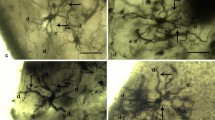The aim of the present work was to analyze changes in the numbers of labile synaptopodin-positive dendritic spines in the parietal cortex and hippocampal field CA1 and the ability of adult rats to remember after repeated transient restraint stress (5 min daily for 10 days). These parameters were compared in animals with normal development and in those subjected to hypoxia during embryogenesis (E14, 7% O2, 3 h). Shortterm and long-term memory were degraded in adult rats with normal embryogenesis subjected to restraint stress, and the number of labile spines was decreased in hippocampal field CA1 (by 17.3 ± 10.4%, p ≤ 0.05) and increased in the molecular layer of the parietal cortex (by 36.9 ± 9.2%) compared with intact control animals. Rats subjected to prenatal hypoxia, regardless of whether or not they had been subjected to restraint stress at the adult stage or not, showed impairments to both short-term and long-term memory, along with decreases in the numbers of labile spines in the hippocampus (by 22.9 ± 10.5%) and the parietal cortex (by 28.1 ± 9.3%). These results lead to the conclusion that increases in plasticity, supporting adaptive behavior in the animals, occur in neural networks in the neocortex in response to repeated transient stress only after normal brain formation during embryogenesis, while impairments to embryogenesis led to decreases in plasticity and the adaptive potentials of the nervous system in further ontogeny.
Similar content being viewed by others
References
I. A. Zhuravin, N. L. Tumanova, and D. S. Vasil’eva, “Changes in the adaptive mechanisms of the brain during ontogeny in rats subjected to prenatal hypoxia,” Dokl. Akad. Nauk., 425, No. 1, 123–125 (2009).
T. Arendt, “Synaptic plasticity and cell cycle activation in neurons are alternative effector pathways: the ‘Dr Jekyll and Mr Hyde concept’ of Alzheimer’s disease or the yin and yang of neuroplasticity,” Progr. Neurobiol., 71, 83–248 (2003).
K. Asanuma, K. Kim, J. Oh, et al., “Synaptopodin regulates the actin-bundling activity of α-actinin in an isoform-specifi c manner,” J. Clin. Invest., 115, 1188–1198 (2005).
Y. N. Biala, Y. Bogoch, C. Behar, et al., “Prenatal stress diminishes gender differences in behavior and in expression of hippocampal synaptic genes and proteins in rats,” Hippocampus, 21, No. 10, 1114–1125 (2011).
J. W. Cohen, N. Louneva, L. Y. Han, et al., “Chronic corticosterone exposure alters postsynaptic protein levels of PSD-95, NR1, and synaptopodin in the mouse brain,” Synapse, 65, No. 8, 763–770 (2011).
T. Deller, C. Bas Orth, A. Vlachos, et al., “Plasticity of synaptopodin and the spine apparatus organelle in the rat fascia dentata following entorhinal cortex lesion,” J. Comp. Neurol., 499, 471–484 (2006).
T. Deller, M. Korte, S. Chabanis, et al., “Synaptopodin-defi cient mice lack a spine apparatus and show defi cits in synaptic plasticity,” Proc. Natl. Acad. Sci. USA, 100, No. 18, 10,494–10,499 (2003).
A. Ennaceur and J. Delacour, “A new one-trail test for neurobiological studies of memory in rats,” Behav. Brain Res., 31, 47–59 (1988).
Y. Hu, J. Zhou, L. Fang, et al., “Hippocampal synaptic dysregulation of exo/endocytosis-associated proteins induced in a chronic mildstressed rat model,” Neuroscience, 230, 1–12 (2013).
I. E. Kudryashov, A. A. Yakovlev, I. Kudryashova, and N. V. Gulyaeva, “Footshock stress alters early postnatal development of electrophysiological responses and caspase-3 activity in rat hippocampus,” Neurosci. Lett., 332, No. 2, 95–98 (2002).
S. J. Martin and R. G. Morris, “Cortical plasticity: it’s all the range!” Curr. Biol., 11, 57059 (2001).
P. B. Mello, F. Benetti, M. Cammarota, and I. Izquierdo, “Effects of acute and chronic physical exercise and stress on different types of memory in rats,” Ann. Acad. Bras. Cienc., 80, 301–309 (2008).
C. Nyakas, B. Buwalda, and P. G. M. Luiten, “Hypoxia and brain development,” Progr. Neurobiol., 49, 1–51 (1996).
R. Okubo-Suzuki, D. Okada, M. Sekiguchi, and K. L Inokuchi, “Synaptopodin maintains the neural activity-dependent enlargement of dendritic spines in hippocampal neurons,” Mol. Cell. Neurosci., 38, 266–277 (2008).
G. Paxinos and C. Watson, The Rat Brain in Stereotaxic Coordinates, Academic Press, San Diego (1998), 4th ed.
H. R. Santos, W. M. Cintra, Y. Aracava, et al., “Spine density and dendritic branching pattern of hippocampal CA1 pyramidal neurons in neonatal rats chronically exposed to the organophosphate paraoxon,” NeuroToxicology, 25, 481–494 (2004).
Author information
Authors and Affiliations
Corresponding author
Additional information
Translated from Rossiiskii Fiziologicheskii Zhurnal imeni I. M. Sechenova, Vol. 99, No. 11, pp. 1233–1239, November, 2013.
Rights and permissions
About this article
Cite this article
Vasil’ev, D.S., Dubrovskaya, N.M., Tumanova, N.L. et al. Effects of Transient Restraint Stress on the Plasticity of the Cortical Areas of the Brain and Cognitive Functions in Adult Rats with Normal and Disturbed Embryogenesis. Neurosci Behav Physi 45, 643–647 (2015). https://doi.org/10.1007/s11055-015-0123-7
Received:
Published:
Issue Date:
DOI: https://doi.org/10.1007/s11055-015-0123-7




